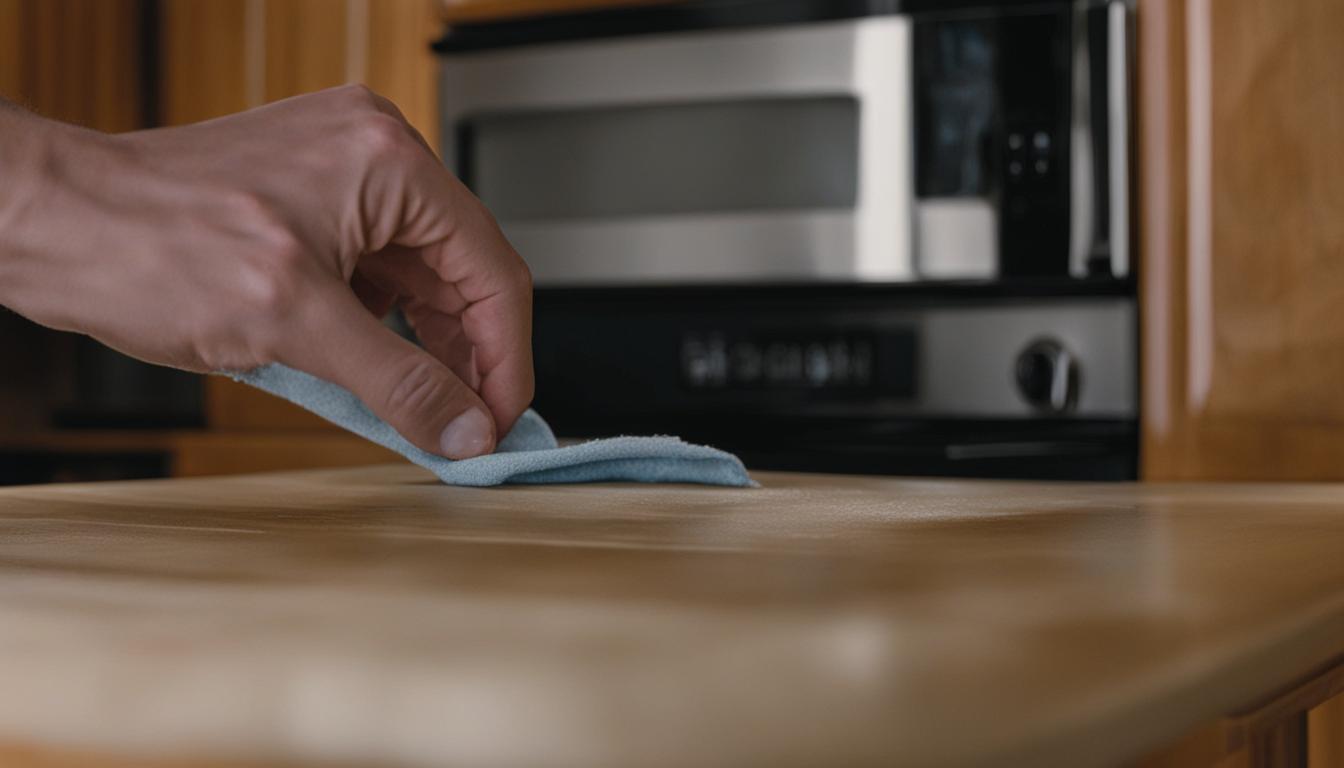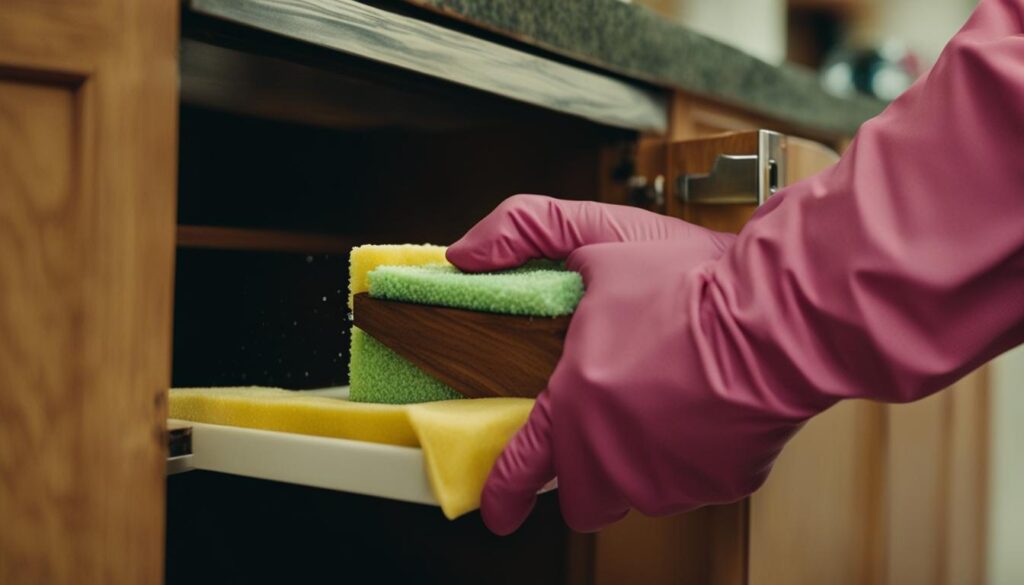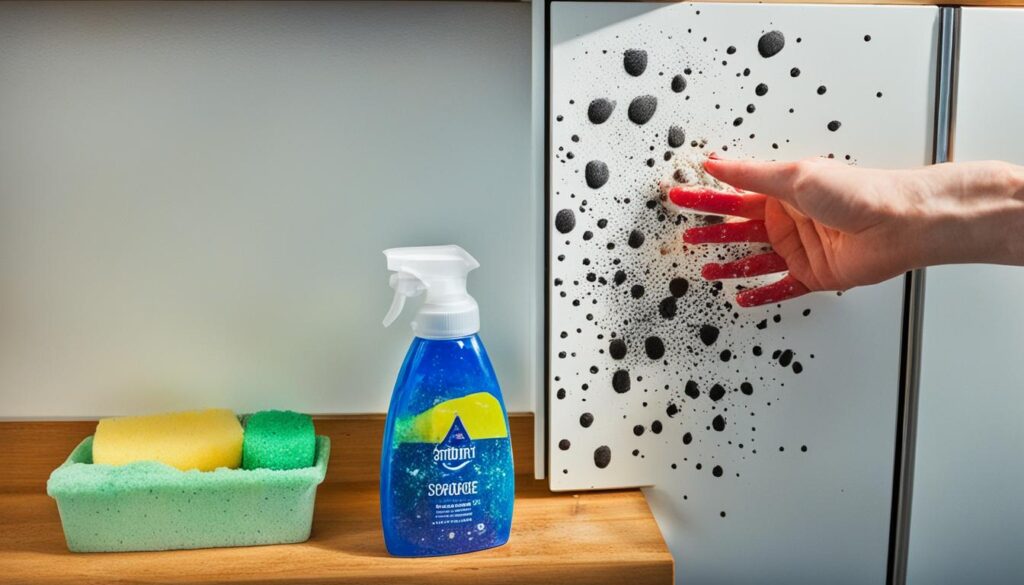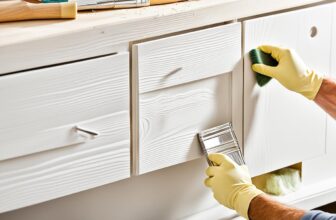Clean Sticky Wood Kitchen Cabinets Easily

Are your kitchen cabinets feeling sticky to the touch? Sticky residue on wood cabinets can be frustrating to deal with, but don’t worry, we’ve got you covered. In this article, we will guide you through the best methods to easily clean sticky wood kitchen cabinets. Say goodbye to that tacky feeling and restore the natural beauty of your cabinets!
Key Takeaways:
- Learn effective tips and natural solutions to remove sticky residue from wood cabinets.
- Discover step-by-step instructions for cleaning and maintaining kitchen cabinets.
- Find out the most effective way to deep clean wooden cabinets without causing damage.
- Explore DIY hacks and natural cleaners for a cost-effective and eco-friendly cleaning solution.
- Learn how to maintain your cabinets and prevent sticky buildup in the future.
Kitchen Cabinet Cleaning Tips
When it comes to maintaining the appearance of your kitchen cabinets, regular cleaning is essential. Sticky residue can build up over time, making your cabinets look dull and unattractive. However, with the right cleaning techniques, you can easily tackle sticky residue and restore the shine to your wood cabinets. Follow these step-by-step instructions to keep your kitchen cabinets looking their best.
1. Empty the Cabinets: Before you start cleaning, remove all items from your cabinets. This will make it easier to access every surface and ensure a thorough clean.
2. Dusting: Use a soft cloth or microfiber duster to remove any dust or loose debris from the cabinets. Dusting regularly will help prevent the buildup of sticky residue.
3. Cleaning Solution: Prepare a gentle cleaning solution by mixing warm water and a mild dish soap or vinegar in a bucket or spray bottle. This solution will effectively remove grease and grime without damaging the wood.
4. Test on an Inconspicuous Area: Before applying the cleaning solution to the entire cabinet surface, test it on a small, inconspicuous area to ensure that it does not cause any discoloration or damage.
5. Wipe the Cabinets: Dip a soft cloth or sponge into the cleaning solution and wring out any excess liquid. Gently wipe the cabinets, paying close attention to areas with sticky residue. For stubborn residue, allow the cleaning solution to sit for a few minutes before wiping it away.
6. Rinse and Dry: After wiping the cabinets, rinse the cloth or sponge with clean water and go over the cabinets again to remove any soap residue. Finally, dry the cabinets thoroughly with a clean, dry cloth to prevent water spots.
TIP: For extra shine, you can use a wood polish specifically designed for kitchen cabinets after cleaning. Follow the manufacturer’s instructions for best results.
By following these kitchen cabinet cleaning tips, you can effectively remove sticky residue and maintain the overall appearance of your cabinets. Regular cleaning will not only keep your cabinets looking beautiful but also extend their lifespan. With a little effort and the right techniques, your kitchen cabinets will always shine.
Best Way to Clean Wooden Cabinets
When it comes to cleaning wooden cabinets, it’s essential to find the best methods that effectively remove sticky buildup without causing any damage. In this section, we’ll share our recommended techniques and products that yield the best results for a deep clean, ensuring your cabinets look as good as new.
1. Gather Your Cleaning Supplies
Before you begin, gather the necessary supplies to clean your wooden cabinets:
- A gentle wood cleaner or mild dish soap
- Warm water
- Microfiber cloths or soft sponges
- Optional: White vinegar or lemon juice
2. Start with a Gentle Cleanser
To clean your wooden cabinets, start by creating a gentle cleaning solution. Mix a small amount of mild dish soap or wood cleaner with warm water in a bucket or bowl.
Pro Tip: Avoid using abrasive cleaners, harsh chemicals, or scrub brushes, as they can damage the wood surface.
3. Apply the Cleaning Solution
Dip a microfiber cloth or soft sponge into the cleaning solution, ensuring it is damp but not soaking wet. Gently wipe down the wooden cabinets, focusing on areas with sticky residue or built-up grime. For tougher stains, you can add a few drops of white vinegar or lemon juice to the cleaning solution.
4. Rinse and Dry
After cleaning, dampen a clean cloth with plain water and rinse off any remaining cleaning solution from the cabinets. Once rinsed, use a dry cloth to thoroughly dry the cabinets, ensuring no moisture is left behind.
5. Polish and Protect
For an extra touch of shine and protection, consider using a high-quality wood polish. Apply the polish according to the manufacturer’s instructions, using a clean cloth or sponge. This will help enhance the natural beauty of your wooden cabinets and create a protective barrier against future sticky buildup.
| Cleaning Method | Pros | Cons |
|---|---|---|
| Gentle Wood Cleaner | – Effective in removing sticky residue – Safe for most types of wood |
– May require additional polishing – May not be suitable for certain finishes |
| Mild Dish Soap | – Readily available – Budget-friendly option |
– May leave streaks or residue if not rinsed properly – May require additional polishing |
| White Vinegar or Lemon Juice | – Natural and eco-friendly – Helps remove tough stains |
– Strong odor – May cause discoloration on certain finishes |
Expert Tip: Test any cleaning solution or polish on a small, inconspicuous area of the cabinet before using it on the entire surface. This will help you ensure compatibility and prevent any potential damage.
By following these steps and using the recommended techniques and products, you can effectively clean your wooden cabinets and eliminate sticky residue. Remember to regularly maintain your cabinets to prevent future buildup and keep them looking their best.
Removing Sticky Residue from Cabinets
Sticky residue on your kitchen cabinets can be stubborn and unsightly. Don’t worry, though – with the right techniques, you can easily remove it and restore the beauty of your cabinets. In this section, we will guide you through effective methods using household items or specific cleaning solutions to leave your cabinets residue-free.
Household Items for Sticky Residue Removal
If you prefer natural solutions, you’ll be pleased to know that several common household items can work wonders in removing sticky residue from cabinets. Here are a few options:
- Vinegar and Water Solution: Create a mixture of equal parts white vinegar and water. Dampen a cloth with the solution and gently scrub the sticky residue. Rinse with water and pat dry.
- Baking Soda Paste: Make a paste using baking soda and water. Apply it to the sticky residue and let it sit for a few minutes. Scrub gently with a cloth or sponge, then rinse and dry.
- Cooking Oil: Apply a small amount of cooking oil to the sticky residue. Let it sit for a few minutes, then wipe it away with a cloth. Repeat if necessary.
Cleaning Solutions for Stubborn Residue
If household items don’t do the trick, there are cleaning solutions specifically designed for removing sticky residue from cabinets. Look for products that are safe to use on wood surfaces. Follow the instructions on the packaging, and always test the solution in an inconspicuous area before applying it to the entire cabinet.
Pro Tip: Remember to wear gloves and work in a well-ventilated area when using cleaning solutions.
Step-by-Step Guide to Removing Sticky Residue
- Clear the cabinet of any items and wipe away loose debris with a dry cloth.
- Choose a suitable cleaning method from the ones mentioned above.
- Apply the chosen solution or household item to a cloth or sponge.
- Gently scrub the sticky residue, being careful not to damage the wood surface.
- Rinse the area with water and wipe dry.
- Repeat the process if necessary, especially for stubborn residue.
Now that you know how to remove sticky residue from cabinets, you can confidently tackle this common kitchen cleaning challenge. Remember to take your time and be gentle to preserve the integrity of your cabinets. With a little effort and the right techniques, your cabinets will be free from sticky residue, and their natural beauty will shine through.
DIY Cabinet Cleaning Hacks
When it comes to cleaning sticky wood kitchen cabinets, sometimes all you need are simple and inexpensive DIY solutions. In this section, we will share some creative hacks using common household ingredients to help you achieve a sparkling clean finish without breaking the bank. These eco-friendly methods are not only effective but also safe for your cabinets.
1. Baking Soda Paste
Create a powerful cleaning paste by mixing baking soda with water. Apply the paste directly to the sticky areas of your cabinets and let it sit for a few minutes. Then, gently scrub the surface with a soft cloth or sponge. The abrasive nature of baking soda will help remove the stickiness without causing any damage.
2. Vinegar and Water Solution
Vinegar is a versatile cleaning agent that can be used to tackle sticky residue on wood cabinets. Mix equal parts white vinegar and water in a spray bottle and spray the solution onto the sticky areas. Let it sit for a few minutes, then wipe it clean with a damp cloth. Vinegar acts as a natural degreaser, making it ideal for removing built-up grime.
3. Lemon Juice and Olive Oil Polish
For a natural and fragrant cabinet polish, combine equal parts lemon juice and olive oil in a small bowl. Dip a soft cloth into the mixture and gently rub it onto your cabinets in circular motions. The lemon juice helps to cut through greasy residue, while the olive oil leaves a protective and shiny finish.
“These DIY cleaning hacks are not only effective but also cost-effective. You can easily find the ingredients in your kitchen pantry and achieve a sparkling clean without relying on harsh chemicals.” – Martha Stewart
4. Toothpaste Magic
Your toothpaste can do more than just maintain your oral hygiene. Apply a small amount of non-gel toothpaste onto a cloth and rub it onto the sticky areas of your cabinets. The mild abrasives in toothpaste help remove residue while leaving a refreshing scent behind. Wipe off any excess toothpaste with a damp cloth.
5. Tea Tree Oil Solution
Tea tree oil is a natural antibacterial and antifungal agent that can help clean and disinfect your cabinets. Mix a few drops of tea tree oil with water in a spray bottle and spritz the solution onto the sticky areas. Let it sit for a few minutes, then wipe it clean with a damp cloth. Tea tree oil will not only remove stickiness but also leave a pleasant scent.
Try these DIY cabinet cleaning hacks to restore the beauty and cleanliness of your sticky wood kitchen cabinets. Not only will you save money, but you will also have peace of mind knowing that you’re using eco-friendly and safe methods to clean your cabinets.
| Hack | Ingredients | Method |
|---|---|---|
| Baking Soda Paste | Baking soda, water | Apply paste, scrub, and wipe clean |
| Vinegar and Water Solution | White vinegar, water | Spray, let sit, and wipe clean |
| Lemon Juice and Olive Oil Polish | Lemon juice, olive oil | Rub onto cabinets in circular motions |
| Toothpaste Magic | Non-gel toothpaste | Rub onto cabinets and wipe clean |
| Tea Tree Oil Solution | Tea tree oil, water | Spray, let sit, and wipe clean |
Natural Cleaners for Sticky Cabinets
If you’re looking to remove sticky residue from your kitchen cabinets without using harsh chemicals, natural cleaners are a great alternative. Not only are they safe for you and the environment, but they are also effective in tackling tough stains and grime. In this section, we’ll share some recipes and tips on how to create your own natural cleaners at home.
1. Vinegar and Water Solution
A simple yet powerful natural cleaner for sticky cabinets is a vinegar and water solution. Mix equal parts distilled white vinegar and water in a spray bottle. Spray the solution onto a microfiber cloth and wipe down your cabinets, focusing on the sticky areas. The vinegar’s acidity helps dissolve the sticky residue, leaving your cabinets clean and fresh.
2. Baking Soda Paste
Baking soda is another versatile ingredient that is excellent for cleaning sticky cabinets. Create a paste by mixing baking soda with a small amount of water. Apply the paste to a cloth or sponge and gently scrub the sticky areas. The abrasive texture of baking soda works wonders in removing the residue while being gentle on your cabinets.
3. Lemon Juice and Olive Oil Mixture
A natural cleaner that not only removes sticky residue but also leaves a pleasant scent is a mixture of lemon juice and olive oil. In a small bowl, combine one part lemon juice with two parts olive oil. Dip a cloth into the mixture and rub it onto your cabinets. The lemon juice acts as a natural degreaser, while the olive oil nourishes the wood, giving it a beautiful shine.
Tip: Always test any natural cleaner on a small, inconspicuous area of your cabinets before applying it to the entire surface. This will ensure that it doesn’t cause any damage or discoloration.
By using these natural cleaners, you can effectively remove sticky residue from your kitchen cabinets while avoiding harsh chemicals. Remember to allow your cabinets to dry completely after cleaning to prevent any moisture-related issues. With these homemade solutions, you can enjoy clean and sparkling cabinets without compromising your health or the environment.
Deep Cleaning Kitchen Cabinets
When kitchen cabinets accumulate stubborn grime and sticky residue, a regular cleaning might not be enough. Deep cleaning is essential to restore their beauty and maintain their longevity. Follow these steps to achieve a thorough clean:
- Remove all items: Begin by emptying the cabinets and removing all items. This will give you clear access to the surfaces and ensure a more effective cleaning process.
- Create a cleaning solution: Mix a few drops of mild dish soap with warm water in a bucket or basin. This solution will help break down grease and grime on the cabinet surfaces.
- Wipe down the exteriors: Dip a soft cloth or sponge into the cleaning solution and wring it out so that it is damp but not dripping. Gently wipe down the exterior surfaces of the cabinets, paying special attention to areas with visible buildup or sticky residue.
- Clean the interiors: Next, focus on the interior shelves and drawers. Remove any crumbs or debris, and wipe them down with the cleaning solution. If necessary, use a toothbrush or small brush to reach into corners or tight spots.
- Tackle sticky residue: For stubborn sticky residue, apply a small amount of vegetable oil or baking soda paste to the affected areas. Let it sit for a few minutes to loosen the residue, then gently scrub with a soft cloth or sponge.
- Rinse and dry: After cleaning, rinse the cabinets with a clean, damp cloth to remove any soapy residue. Use a separate cloth or towel to dry them thoroughly to prevent moisture damage.
- Polish the wood: If your cabinets have a wood finish, consider applying a wood polish or conditioner. This will help restore the natural shine and protect the wood from future damage.

Pro Tip: To maintain the cleanliness of your kitchen cabinets, wipe them down regularly with a damp cloth and mild detergent. This will help prevent sticky residue from building up and make future cleanings easier.
By following these steps and incorporating regular deep cleaning into your kitchen maintenance routine, you can ensure that your cabinets remain in excellent condition and free from sticky residue.
Recommended Cleaning Products
| Product | Description |
|---|---|
| Mild dish soap | Gentle yet effective in breaking down grease and grime. |
| Vegetable oil | Helps to dissolve sticky residue and restore shine to wood cabinets. |
| Baking soda | Acts as a natural abrasive to remove tough stains and residue. |
| Wood polish or conditioner | Enhances the beauty of wood and provides protection against future damage. |
Maintaining Wood Cabinets
Once you’ve cleaned and restored your sticky wood kitchen cabinets, it’s essential to maintain their cleanliness and appearance to prevent future buildup. Regular cleaning and care are key to ensuring your cabinets remain in optimal condition. Here are some practical tips to help you maintain your wood cabinets:
- Wipe cabinets regularly: Use a soft cloth or microfiber cloth to wipe down the surface of your cabinets regularly. This helps to prevent dust, dirt, and grime from accumulating.
- Avoid harsh chemicals: When cleaning your cabinets, steer clear of harsh chemicals and abrasive cleaners that can damage the wood. Instead, opt for gentle, non-abrasive cleaning solutions that are safe for wood surfaces.
- Remove spills promptly: Accidents happen, but it’s important to clean up spills as soon as possible to prevent them from causing stains or sticky residue on your cabinets.
- Use cabinet liners: Consider using cabinet liners to protect the interior of your cabinets from spills and stains. Liners also make it easier to clean and maintain the shelves.
- Avoid excessive moisture: Wood cabinets are susceptible to damage from excess moisture. Be mindful of steam from cooking or damp fabrics near your cabinets and take steps to minimize moisture exposure.
- Avoid extreme temperature changes: Rapid changes in temperature can cause wood to expand or contract, leading to potential damage. Keep your kitchen properly ventilated and maintain a consistent temperature to preserve your cabinets.
- Regularly inspect and repair: Periodically inspect your cabinets for any signs of wear, such as loose hinges or chipped paint. Address these issues promptly to prevent further damage and maintain the structural integrity of your cabinets.
Expert Tip:
Apply a thin layer of wax or furniture polish to your wood cabinets every few months to protect the finish and enhance their natural beauty.
By following these tips, you can ensure that your wood cabinets stay clean, beautiful, and free from sticky buildup. Regular maintenance will not only preserve the appearance of your cabinets but also extend their lifespan.
| Cabinet Maintenance Tips | |
|---|---|
| Wipe cabinets regularly | Use a soft cloth or microfiber cloth to wipe down the surface of your cabinets regularly. |
| Avoid harsh chemicals | Steer clear of harsh chemicals and abrasive cleaners that can damage the wood. |
| Remove spills promptly | Clean up spills as soon as possible to prevent them from causing stains or sticky residue on your cabinets. |
| Use cabinet liners | Consider using cabinet liners to protect the interior of your cabinets from spills and stains. |
| Avoid excessive moisture | Be mindful of steam from cooking or damp fabrics near your cabinets. |
| Avoid extreme temperature changes | Keep your kitchen properly ventilated and maintain a consistent temperature to preserve your cabinets. |
| Regularly inspect and repair | Periodically inspect your cabinets for any signs of wear and address these issues promptly. |
Kitchen Cabinet Degreasing Tips
Grease and oil splatters can leave your kitchen cabinets sticky and dull. To restore their shine, try these effective techniques for degreasing sticky wood kitchen cabinets, especially in areas prone to splatters.
1. Natural Citrus Cleaner
Create a natural degreaser by mixing equal parts water, vinegar, and lemon juice. Apply the mixture to the sticky areas of your cabinets using a soft cloth or sponge. The citric acid in lemon juice helps break down grease, while vinegar acts as a natural disinfectant.
2. Baking Soda Paste
Baking soda is a versatile cleaning agent that can help remove grease buildup from cabinets. Make a paste by mixing baking soda with water until it forms a thick consistency. Apply the paste to the sticky areas, gently scrub with a non-abrasive sponge, and then wipe clean with a damp cloth.
3. Dish Soap Solution
Fill a bucket or sink with warm water and add a few drops of dish soap. Dip a sponge or cloth into the soapy solution and wring out the excess water. Wipe down the sticky cabinets, paying extra attention to the greasy spots. Rinse the sponge or cloth frequently and change the soapy water as needed.
4. Microfiber Cloth
Microfiber cloths are excellent for cleaning greasy surfaces as they have tiny fibers that capture and hold onto dirt and grime. Dampen a microfiber cloth with warm water and gently wipe down the cabinets, focusing on the sticky areas. For stubborn grease spots, use a bit of dish soap on the cloth.
5. All-Purpose Degreaser
If you have particularly stubborn grease buildup on your cabinets, consider using a commercial degreaser. Look for an all-purpose degreaser specifically designed for wood surfaces. Follow the instructions on the packaging and test it on a small, inconspicuous area of your cabinets before applying it to the entire surface.
Pro Tip: Always wear gloves and work in a well-ventilated area when using chemical-based cleaners.
By following these kitchen cabinet degreasing tips, you can remove accumulated grease and restore the shine to your cabinets. Remember to regularly clean and maintain your cabinets to prevent sticky buildup and keep them looking their best.

[Additional keyword]
Along with the previously mentioned kitchen cabinet cleaning tips, here are some additional hacks and tricks to help you achieve the best results:
- Use vinegar and water solution: Create a natural cleaner by mixing equal parts white vinegar and water. This solution works wonders in removing sticky residue from cabinets.
- Try baking soda paste: For tougher stains and greasy buildup, make a paste by combining baking soda and water. Gently scrub the affected areas with this paste using a soft cloth or sponge.
- Utilize lemon juice: The acidity in lemon juice helps break down grime and sticky residue. Apply lemon juice directly to the affected areas, let it sit for a few minutes, then wipe it clean.
- Organize your cabinet interiors: Take the opportunity while cleaning to declutter and organize your cabinet interiors. Remove expired food, unused items, and reorganize your items for a more functional and visually pleasing cabinet.
Remember to always test any cleaning solution on a small, inconspicuous area before applying it to the entire surface. This will help ensure that the solution does not cause any damage or discoloration to your cabinets.
Now that you have learned various techniques and hacks for cleaning sticky wood kitchen cabinets, you can enjoy a clean and fresh kitchen environment. Regular maintenance and proper cleaning will not only enhance the appearance of your cabinets but also help prolong their lifespan.
Take pride in your sparkling clean cabinets and enjoy the satisfaction of a well-maintained kitchen space!
Conclusion
In conclusion, cleaning sticky wood kitchen cabinets doesn’t have to be a daunting task. By following the tips and techniques outlined in this article, you can effectively remove sticky residue, restore the shine, and maintain the cleanliness of your cabinets.
Regular maintenance is key to preventing sticky buildup and preserving the beauty of your cabinets. Make sure to wipe down your cabinets regularly with a gentle cleaning solution or a mixture of vinegar and water to remove any grease or grime that may accumulate.
When tackling stubborn sticky residue, opt for the appropriate cleaning method based on the severity of the buildup. Whether using natural cleaners like baking soda or commercial cleaning products specifically designed for wood surfaces, always test on a small, inconspicuous area first to ensure they don’t cause any damage.
Remember, proper care and maintenance will not only keep your cabinets looking their best but also extend their lifespan. So, take the time to clean and maintain your wood kitchen cabinets regularly, and enjoy the beauty and functionality they bring to your kitchen for years to come!







